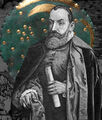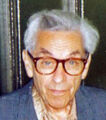Template:Selected anniversaries/March 26: Difference between revisions
No edit summary |
No edit summary |
||
| Line 1: | Line 1: | ||
<gallery> | <gallery> | ||
||1484 | ||1484: William Caxton prints his translation of ''Aesop's Fables''. | ||
||1535 | ||1535: Georg Tannstetter dies ... mathematician, astronomer, and cartographer. | ||
| | ||1656: Nicolaas Hartsoeker born ... mathematician and physicist. | ||
||1698: Prokop Diviš born ... priest, scientist and inventor. | |||
||1698 | |||
||1753: Benjamin Thompson Rumford born ... physicist, government administrator, and a founder of the Royal Institution of Great Britain, London. Because he was a Redcoat officer and an English spy during the American revolution, he moved into exile in England. Through his investigations of heat he became one of the first scientists to declare that heat is a form of motion rather than a material substance, as was popularly believed until the mid-19th century. Among his numerous scientific contributions are the development of a calorimeter and a photometer. He invented a double boiler, a kitchen stove and a drip coffee pot. Pic. | ||1753: Benjamin Thompson Rumford born ... physicist, government administrator, and a founder of the Royal Institution of Great Britain, London. Because he was a Redcoat officer and an English spy during the American revolution, he moved into exile in England. Through his investigations of heat he became one of the first scientists to declare that heat is a form of motion rather than a material substance, as was popularly believed until the mid-19th century. Among his numerous scientific contributions are the development of a calorimeter and a photometer. He invented a double boiler, a kitchen stove and a drip coffee pot. Pic. | ||
||1773 | ||1773: Nathaniel Bowditch born ... mathematician and navigator. | ||
File:Nathaniel Bowditch.jpg|link=Nathaniel Bowditch (nonfiction)|1773: American captain and mathematician [[Nathaniel Bowditch (nonfiction)|Nathaniel Bowditch]] born. He will be a founder of modern maritime navigation; his book ''The New American Practical Navigator'', first published in 1802, will be carried on board every commissioned U.S. Naval vessel. | File:Nathaniel Bowditch.jpg|link=Nathaniel Bowditch (nonfiction)|1773: American captain and mathematician [[Nathaniel Bowditch (nonfiction)|Nathaniel Bowditch]] born. He will be a founder of modern maritime navigation; his book ''The New American Practical Navigator'', first published in 1802, will be carried on board every commissioned U.S. Naval vessel. | ||
| Line 20: | Line 18: | ||
File:John Mudge.jpg|link=John Mudge (nonfiction)|1793: Physician and engineer [[John Mudge (nonfiction)|John Mudge]] dies. He was the first self-proclaimed civil engineer, and often regarded as the "father of civil engineering". | File:John Mudge.jpg|link=John Mudge (nonfiction)|1793: Physician and engineer [[John Mudge (nonfiction)|John Mudge]] dies. He was the first self-proclaimed civil engineer, and often regarded as the "father of civil engineering". | ||
||1793 | ||1793: John Mudge dies ... physician and engineer. | ||
||1797 | ||1797: James Hutton born ... geologist and physician. | ||
||Wolfgang von Kempelen | ||1804: Wolfgang von Kempelen dies ... author and inventor, known for his chess-playing "automaton" hoax The Turk and for his speaking machine. Pic. | ||
||1812 | ||1812: A political cartoon in the Boston Gazette coins the term "gerrymander" to describe oddly shaped electoral districts designed to help incumbents win reelection. | ||
File:George Chrystal.jpg|link=George Chrystal (nonfiction)|1851: Mathematician [[George Chrystal (nonfiction)|George Chrystal]] born. He will be awarded a Gold Medal from the Royal Society of London (confirmed shortly after his death) for his studies of [[Seiche (nonfiction)|seiches]] (wave patterns in large inland bodies of water). | File:George Chrystal.jpg|link=George Chrystal (nonfiction)|1851: Mathematician [[George Chrystal (nonfiction)|George Chrystal]] born. He will be awarded a Gold Medal from the Royal Society of London (confirmed shortly after his death) for his studies of [[Seiche (nonfiction)|seiches]] (wave patterns in large inland bodies of water). | ||
||1859 | ||1859: Adolf Hurwitz born ... mathematician and academic. | ||
||Antonio Maria Bordoni | ||1860: Antonio Maria Bordoni dies ... mathematician who did research on mathematical analysis, geometry, and mechanics. | ||
||1875 | ||1875: Max Abraham born ... physicist and academic. | ||
||1884 | ||1884: Georges Imbert born ... chemical engineer and inventor. | ||
||Theodore Samuel Motzkin | ||1908: Theodore Samuel Motzkin born ... mathematician. | ||
File:Carl Gottfried Neumann.jpg|link=Carl Gottfried Neumann (nonfiction)|1909: Mathematician [[Carl Gottfried Neumann (nonfiction)|Carl Gottfried Neumann]] uses the finite propagation of electrodynamic actions to detect and prevent [[crimes against mathematical constants]]. | File:Carl Gottfried Neumann.jpg|link=Carl Gottfried Neumann (nonfiction)|1909: Mathematician [[Carl Gottfried Neumann (nonfiction)|Carl Gottfried Neumann]] uses the finite propagation of electrodynamic actions to detect and prevent [[crimes against mathematical constants]]. | ||
||1910 | ||1910: Auguste Charlois dies ... astronomer. | ||
||1893 | ||1893: James Bryant Conant born ... chemist, academic, and diplomat, 1st United States Ambassador to West Germany. | ||
||1911 | ||1911: Bernard Katz born ... biophysicist, Nobel Prize laureate. | ||
File:Paul Erdős.jpg|link=Paul Erdős (nonfiction)|1913: Mathematician and academic [[Paul Erdős (nonfiction)|Paul Erdős]] born. He will firmly believe mathematics to be a social activity, living an itinerant lifestyle with the sole purpose of writing mathematical papers with other mathematicians. | File:Paul Erdős.jpg|link=Paul Erdős (nonfiction)|1913: Mathematician and academic [[Paul Erdős (nonfiction)|Paul Erdős]] born. He will firmly believe mathematics to be a social activity, living an itinerant lifestyle with the sole purpose of writing mathematical papers with other mathematicians. | ||
||1914 | ||1914: Toru Kumon born ... mathematician and academic. | ||
||1916: Christian B. Anfinsen born ... biochemist and academic, Nobel Prize laureate. | |||
|| | ||1922: Oscar Sala born ... physicist and academic. | ||
||1922 | ||1922: Guido Stampacchia born ... mathematician and academic ... known for his work on the theory of variational inequalities, the calculus of variation and the theory of elliptic partial differential equations. | ||
|| | ||1932: Henry M. Leland dies ... machinist, inventor, engineer, automotive entrepreneur and founded of Cadillac and Lincoln. | ||
|| | ||1933: József Kürschák dies ... mathematician noted for his work on trigonometry and for his creation of the theory of valuations. He proved that every valued field can be embedded into a complete valued field which is algebraically closed. | ||
|| | ||1938: Anthony James Leggett born ... physicist and academic, Nobel Prize laureate (alive Aug. 2018). | ||
|| | ||1940: Wilhelm Anderson dies ... astrophysicist. | ||
|| | ||1953: Jonas Salk announced the successful test of his polio vaccine on a small group of adults and children (vaccination pictured). Pic. | ||
|| | ||1958: The United States Army launches Explorer 3. | ||
|| | ||1974: Edward Uhler Condon dies ... nuclear physicist, a pioneer in quantum mechanics, and a participant in the development of radar and nuclear weapons during World War II as part of the Manhattan Project. The Franck–Condon principle and the Slater–Condon rules are co-named after him. | ||
|| | ||1975: The Biological Weapons Convention comes into force. | ||
|| | ||1983: Anthony Frederick Blunt dies ... leading British art historian who in 1964, after being offered immunity from prosecution, confessed to having been a Soviet spy. Blunt had been a member of the Cambridge Five, a group of spies working for the Soviet Union from some time in the 1930s to at least the early 1950s. His confession, a closely held secret for many years, was revealed publicly by Prime Minister Margaret Thatcher in November 1979. | ||
||Paul Baran | ||2011: Paul Baran dies ... engineer who was a pioneer in the development of computer networks. He was one of the two independent inventors of packet switched computer networking, and went on to start several companies and develop other technologies that are an essential part of modern digital communication. Pic. | ||
||2015 | ||2015: Friedrich L. Bauer ... mathematician, computer scientist, and academic. | ||
</gallery> | </gallery> | ||
Revision as of 18:01, 24 August 2018
1773: American captain and mathematician Nathaniel Bowditch born. He will be a founder of modern maritime navigation; his book The New American Practical Navigator, first published in 1802, will be carried on board every commissioned U.S. Naval vessel.
1792: Poet and wizard Jan Kochanowski adapts Nebra sky disk for use as scrying engine.
1793: Physician and engineer John Mudge dies. He was the first self-proclaimed civil engineer, and often regarded as the "father of civil engineering".
1851: Mathematician George Chrystal born. He will be awarded a Gold Medal from the Royal Society of London (confirmed shortly after his death) for his studies of seiches (wave patterns in large inland bodies of water).
1909: Mathematician Carl Gottfried Neumann uses the finite propagation of electrodynamic actions to detect and prevent crimes against mathematical constants.
1913: Mathematician and academic Paul Erdős born. He will firmly believe mathematics to be a social activity, living an itinerant lifestyle with the sole purpose of writing mathematical papers with other mathematicians.





